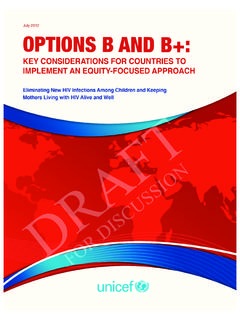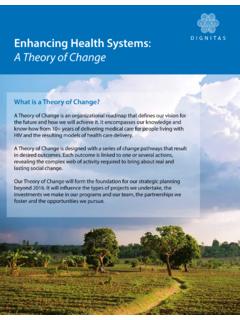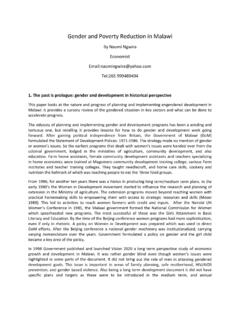Transcription of For - Small Scale Livestock & Livelihoods Program
1 Training NotesForCommunity Animal Health WorkersPig productionSmall Scale Livestock and Livelihoods ProgramPO Box 1604, Lilongwe malawi P i g p r o d u c t i o nSession 1 : Introduction to pig productionSession Objectives:At the end of this training session, each participantshould be able to: 1. Describe the various ways under which pigs are raised in Malawi2. Understand the importance of pigs for all purposes in Malawi3. Explain the importance and benefits of improvement in themanagement of pigsGeneral Information on Pig ProductionExercise: Discuss the reasons why people raise pigs (each participant shouldstate reasons for the pigs that are raised in his/her area).
2 Create alist that ranks the reasons from the most important to the leastimportant. Consider the following reasons as well as any otherreasons you think are relevant. Meat for consumption Income from sale of pigs Manure for crops Lard (pig fat) for cooking Exercise: Discuss the various ways of raising pigs in malawi . Consider thecategories shown in the table provided below: Training notes for community animal health workers - Pig productionPage 1 Production SystemDescription High inputproductionsystemIntensive production accounts for less than 12% ofthe pig production in malawi and a higher percentageof total output.
3 This type of producer is entirely commercial, usesexotic breeds like Large White and Landrace, feeds aprepared ration and follows good practices for herdhealth and management. Medium inputproductionsystemsPig breeds are basically Landrace, Large White andcrosses with indigenous species. These pigs are housed full time. Feed may be commercial rations, home-maderations, house refuse and industrial wastes. Pigs may be kept part of their life in paddocks oftenwith access to grazing. Balanced concentrates maybe fed at times. The pigs are brought indoors for farrowing, rearingand finishing to slaughter.
4 Low inputproductionsystems (freerangesystems)*Pigs are basically indigenous breeds and are onlyoccasionally housed. The animals are generally on free-range scavengingsystem. These however contribute over 50% of all porkconsumed in malawi . Pigs roam at liberty and scavenge much of their are confined in huts at times and may be fed onswill, crop residues and banana chops. This system is not recommended because it has ahigh risk of diseases including zoonotic disease(diseases which can infect both animals and man). These notes are concerned with the second system above, where pigs arehoused full time and fed properly.
5 *Free range pigs are regarded as an opportunistic enterprise. This form of pig production is notrecommended for malawi . There is a law which actually makes free-range pig keeping illegal. The risk ofdisease is very high and some of these diseases affect humans. We will not discuss free range pigs notes for community animal health workers - Pig productionPage 2 Exercise: Discuss the inputs (everything that has to be purchased or built orobtained, including labour) for pigs under each of the productionsystems. Consider the following inputs: Labour Feed Housing Medicines and vaccines Transport for feed and transport for pigs Costs of slaughter Exercise: Discuss the outputs for pig production under each productionsystem.
6 Consider the following: The number of pigs sold each year for each breeding sow kept The quantity of meat produced and sold The total income derived for each sow kept By-products, ie manure and lard Losses from poor nutrition and diseaseDiscuss also the following aspects of each production system: disease in pigs health threats to humans from diseases in the pigs Training notes for community animal health workers - Pig productionPage 3 Session 2 : Housing for PigsSession Objectives:At the end of this training session, each participant should be able to: 1. Understand the basic principles of housing for pigs2.
7 Describe how to build a suitable khola for pigsExercise: Discuss the attributes of a good khola for pigs. Consider the siting,the size, the roofing, the eating and drinking area and generalcleanliness within the khola. General principles Siting of the khola should take into account several elements: If there is a risk of theft, the khola might best be placed close to the also whether the front of the khola should be facing the house. Consider the risk of unpleasant smell from the khola. It should be in aposition such that smell is not a major problem. The khola should be sited on high ground so that it will not become muddyin the wet season.
8 The slope of the floor should be such that run-off will exit the khola andnot accumulate inside. Pigs are creatures of habit. If they have adequate space, they will set asidea toilet area for defecating, separate from the area where they habitually they do not set aside such an area, it is usually because they are stressedthrough lack of space or they are suffering from some other problem to dowith their management. The pig khola should include a closed area which is adequately ventilated butfree from excessive draughts. Piglets need warmth and can suffer or die ifthey get too cold.
9 Training notes for community animal health workers - Pig productionPage 4 Pig khola suitable for one sow and pigletsSide elevation of the pig kholaPlan for a pig khola (from above)Double fencing The risk of the disease African swine fever is of particular concern for smallpiggeries. One step to reduce the risk of this disease is to create an outerperimeter fence for the entire piggery with only one entry/exit point. At thatpoint, people entering the piggery area should be able to wash their handswith soap and water, and perhaps disinfectant. Training notes for community animal health workers - Pig productionPage 5 Feed and water troughs Feeding troughs should be large enough so that all pigs can feed at actual size of trough space will depend on the size of the pigsthemselves.
10 As a guide, feeding troughs should be at least 20 cm wide(inside measurement) and for grown pigs, the length should be 20 cm foreach pig. Cement troughs built into the housing structure have the advantage that theycannot easily be damaged or destroyed by the pigs. Water troughs should be deep enough that the pigs cannot spill or empty thecontents. Again, they can be built into the structure of the khola. The widthof the water trough should be about 20 cm and the length about 1 metre. Training notes for community animal health workers - Pig productionPage 6 Session 3 : Feeding and Nutrition in PigsSession Objectives:At the end of this training session, each participant should be able to: 1.






